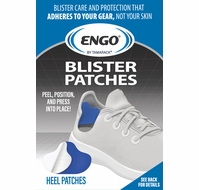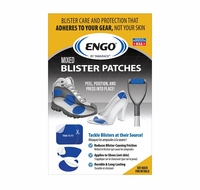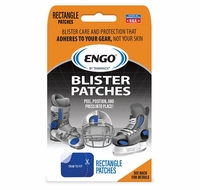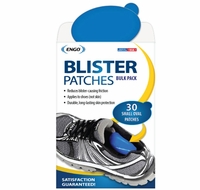 73,141+ 4.8 Star Reviews
73,141+ 4.8 Star Reviews TOTALLY SECURE SHOPPING
Shop Here with Confidence
TOTALLY SECURE SHOPPING
Shop Here with Confidence
 CERTIFIED ATHLETIC TRAINER
Owned by Industry Professionals
CERTIFIED ATHLETIC TRAINER
Owned by Industry Professionals
 FAST, FRIENDLY & RELIABLE
Flexible Shipping Options
FAST, FRIENDLY & RELIABLE
Flexible Shipping Options
 HEALTH CARE PROFESSIONAL
On-Staff and Ready to Help!
HEALTH CARE PROFESSIONAL
On-Staff and Ready to Help!
ENGO Oval Blister Patch (6 Pack) Mixed
 INCLUDES FREE INSURED SHIPPING
INCLUDES FREE INSURED SHIPPING- Description ∨
- QUESTIONS & ANSWERS ∨
- PRODUCT REVIEWS ∨
- RECENTLY VIEWED ∨

ENGO™ Six Pack
This is one of our most popular ENGO™ products. The Six Pack contains an assortment of both large and small ENGO ovals to help treat hot-spots and blisters by reducing the friction that causes blisters. These self-adhesive patches are an invaluable addition to conventional bandage coverings in the treatment and prevention of blisters since ENGO tackles blisters at their source! Convenient and easy to use, simply apply ENGO patches to athletic shoes, casual or dress shoes, insoles, or athletic equipment such as ice skates, helmet, hiking & hunting boots, and the long-lasting, low-friction ENGO surface will do the rest.
“Don’t let blisters hold you back. Stay active & blister free with ENGO Blister Patches!”
ENGO™ Features:
- Applied directly to shoes, or equipment, not to skin. One patch will last for months!
- Great for all types of footwear.
- Helps reduce friction from prosthetics, braces, and equipment.
- Can be used to relieve discomfort from hammer toe, calluses, heel spurs, and bunions.
- Reduces friction from paddles, oars, rake and shovel handles.
- Sweat-proof and latex-free.
- Contains 2 small and 4 large ovals.
What happens to the performance of ENGO
when my footwear gets wet?
ENGO Patches retain their low-friction property when they get wet. ENGO Blister Prevention Patches have been reformulated to hold up better against sweat and moisture within your footwear than ever before. Whether you’re caught in the rain during a run or you simply sweat (a little or A LOT), our redesigned ENGO Patches have been tested to withstand water submersion (installed on standard insole materials) for 10 minutes with only a 25% average reduction in peel strength (resistance to peel from the material onto which it is installed). Our new ENGO Patches are better than ever to live up to the rigorous demands of our customers!
ENGO patches come in the following sizes:
Small oval: 2 ×1½” (3.8 x 5.1cm)
Large oval: 2¾ × 1¾” (4.4 x 7cm)
Rectangle: 3¾ × 2¾” (7 x 9.5cm)
Heel patch: 3¾ × 1¾” (3.8 x 9.1cm)
All ENGO patches are 0.015 inch thick. Most credit cards are 0.032 inch thick. Thus, ENGO is about ½ as thick as your credit card. When ENGO is applied to footwear, volume is virtually unaltered
As long as you store your patches in the resealable bag provided, ENGO will last several years. When patches are not protected, the adhesive shelf life may be limited to 24 months.
The toe area of some footwear is so small that you may not be able to easily apply ENGO patches in this location. In that case, go ahead and put it on your socks. But note that while ENGO stands up to sweat, we can’t guarantee it will stand up to the 45 gallons of warm, soapy water used in the wash cycle.
We do not recommend applying ENGO patchesdirectly to skin. ENGO was designed for equipment, socks, insoles and footwear,so we guarantee its effectiveness for those applications. ENGO patches have notbeen tested on skin, so we cannot guarantee how long it will adhere to skin.Adhesive may cause skin injury (it may not stick, or it may stick so well thatit might tear the skin, or it may be irritating to the skin).
It depends on your activity level, specificapplication, and terrain. Many ENGO users have gone 300+ miles on one patch,the recommended interval for replacing athletic shoes. Replace patches when thetop layer wears through (the backing will show ‘white’) or when your patchpeels away from the footwear material.
When installing ENGO Patches in the back ofyour shoes, use caution when slipping your foot into your shoes each day toavoid accidentally peeling the leading edge of the patch with your sock. Wrap abit over the edge of the shoe to help it stay on or use a shoehorn if needed.This will help maximize the lifespan of the patches, keeping you inblister-free comfort for a longer period of time.
Yes! Calluses are caused by the friction that causes blisters. The difference is that calluses develop over time at less intense levels of friction and take longer to form. When you use ENGO, you reduce friction and, as a result over time, callus thickness. Callus reduction may take 1-3 months due to the delay in your skin’s responsiveness.
Yes! Apply ENGO to your footwear where friction is causing a blister. The friction is the ROOT CAUSE! ENGO virtually eliminates rubbing between your footwear and your sensitive, damaged skin. With ENGO, you’ll experience immediate relief.
If I have trouble getting the patches to stick,
what can I do?
Often, using a hair dryer to soften the patches adhesive (after applying the patches to your footwear) will allow the adhesive to better bond to the lining of your footwear. However, if this does not work for you, consider the following option.
If your footwear lining has been treated with a waterproofing or conditioning process, it may be difficult for the patches adhesive to bond securely to your footwear. In this case, we recommend using ShoeGoo, a common shoe repair adhesive that bonds firmly to flexible materials.
You might also have trouble getting the patches to stick if your footwear is very dirty. If that’s the case, clean your shoes thoroughly and allow them to dry completely. Then apply the ENGO patch to the desired area. You can also use ShoeGoo or the hair dryer technique, as described above, to help ensure strong adhesion between the patch and footwear.
Before using ShoeGoo or a similar adhesive, be sure to identify the correct placement of your ENGO® Blister Prevention Patches, and follow the instructions on the adhesive’s package to ensure optimal results.
These patches are so versatile that it is hard to answer this questions. A few examples are runners, dancers, hikers, sports where athletes wear cleats. There are so many more. We would love to hear from you what you use them for....
How is ENGO different than other blister
products?
ENGO patches go permanently onto the shoe, for long term protection, rather than needing to pre-bandage, wrap, or whatever prevention techniques you use each time before lacing up your shoes. ENGO patches are long-lasting (long lasting means weeks/months/ not hours/days atypical for bandages). Taping, bandaging, and applying gels are short-term solutions. ENGO patches provide immediate relief from existing blisters and multi-week protection from future occurrences. Lubricants, lotions, and gels may reduce friction initially, but overhydrate the skin and when absorbed into the skin, can leave a surface that is actually stickier than before (or not using at all). Because of this, they need to be reapplied every few hours, and blister bandages usually need to be reapplied daily (sometimes the friction that caused the blister will rub off the bandage!). ENGO users report that they’ve gotten 300+ miles of use out of their patches.
ENGO patches are comfortable and ultra thin. You apply them to your footwear, not to your skin, so you avoid the skin irritation sometimes associated with adhesives.
ENGO patches address the root cause of blisters by reducing the friction that causes blisters and preventing blisters from forming.
Blisters are caused, in large part, by friction. Heat and the resulting perspiration increase friction and weaken the skin. Heat and moisture are inevitable when you exercise, but ENGO reduces friction to levels that prevent blisters—despite the presence of heat and moisture.

 Secure Shopping
Secure Shopping MY CART
MY CART












